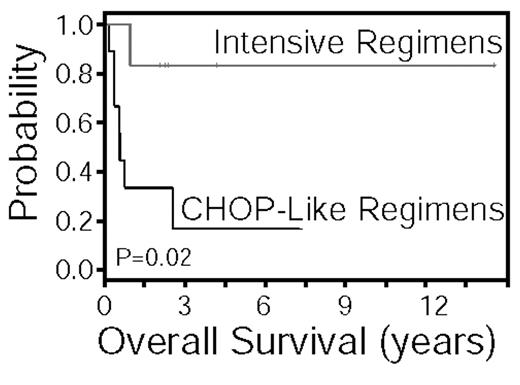Abstract
Background
Burkitt lymphoma(BL) is a potentially curable, aggressive lymphoma. The distinction between BL and diffuse large B-cell lymphoma (DLBCL) is important because they differ significantly in clinical management. The distinction can be difficult because DLBCL can resemble BL in morphology, immunophenotype and cytogenetics. We investigated whether gene expression profiling (GEP) could create a molecular definition of BL that can reliably distinguish it from DLBCL.
Methods
Biopsy samples were collected from 312 patients with a diagnosis of sporadic BL or Burkitt-like lymphoma, or DLBCL. All cases were reviewed by a panel of expert hematopathologists. GEP of all the samples was carried out using a specialized oligonucleotide microarray. We constructed a predictor using 197 genes to distinguish BL from each molecular subtype of DLBCL. Leave-one-out cross-validation was used to evaluate the predictor’s performance. Chemotherapy treatments were grouped into either CHOP-like(CHOP, CNOP) or intensive(BFM, CODOX-M IVAC, regimens requiring stem cell rescue).
Results
After pathology review, the samples were reclassified as:classic BL(25 cases), atypical BL(19), DLBCL(261), and unclassifiable lymphoma(7). All classic BL and 18/19 cases of atypical BL shared a profile that was strikingly different from that of all the molecular subtypes of DLBCL, including those DLBCL cases that have a c-myc translocation. C-myc and its target genes, and genes related to germinal center differentiation were expressed at high levels in BL. NF-kB and its target genes and MHC class-I genes were expressed at very low levels in BL. Interestingly, 10 cases that were DLBCL by pathology were classified as BL by the predictor. The diagnosis of BL was supported by FISH analysis indicating a c-myc translocation. Among adults identified as having BL by the predictor (with full clinical data in N=15), overall survival was markedly superior for those receiving intensive regimens compared to CHOP-like regimens(Fig 1). The groups were similar with regard to age, stage, performance status and sites of involvement.
Conclusion
This study demonstrates that the molecular characteristics of BL can be used to accurately distinguish it from DLBCL. Importantly, a subgroup of BL was identified by the predictor that could not be diagnosed as BL by conventional criteria. The ability of the predictor to identify patients who benefit from aggressive therapies suggests that it will be useful in the diagnosis and management of patients with Burkitt lymphoma.
Author notes
Corresponding author


This feature is available to Subscribers Only
Sign In or Create an Account Close Modal